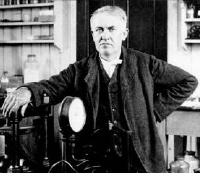Thomas Alva Edison
Inventor and promoter of applied research, b. 11 February 1847 (Milan, Ohio, USA), d. 18 October 1931 (West Orange).
 Thomas Edison is the incarnation of North American technological development and one of the fathers of the age of universal electricity. Hard of hearing at an early age, Edison could not follow school lessons and left school at the age of 11 to work on the railroads.
Thomas Edison is the incarnation of North American technological development and one of the fathers of the age of universal electricity. Hard of hearing at an early age, Edison could not follow school lessons and left school at the age of 11 to work on the railroads.
In 1863 Edison found a position as apprentice telegrapher, employment that suited him well because the coded messages were received as a series of dashes and dots on a paper strip and read from the paper, which meant that his hearing impairment did not put him at a disadvantage.
When the railroads introduced a telegraph that transmitted the code as audible clicks Edison thought about ways to remain in employment. By Janury 1869 he had developed a duplex telegraph that could transmit two messages simultaneously over one wire and a printer, which converted code into letters automatically. He decided to give up telegraphy and become a professional inventor.
With the help of various partnerships Edison went into industrial production of telegraph printers. He developed a quadruplex telegraph for simultaneous transmission of four messages and sold the idea for $100,000, then an immense sum of money. But he was not adept at financial management, and by 1875 he was in financial difficulties. In an effort to have someone else take control of his finances he managed to get his father to build a laboratory and machine shop in Menlo Park, New Jersey, which he and two associates used for ten years.
Although Edison focussed on "invention on demand", some of his best inventions were the result of keen observation of the unexpected. In 1877 Edison was working on the construction of a telephone printer, a machine that was to convert the spoken word into print (a goal he never reached). As a first step he recorded the sound with a stylus on waxed paper. To his suprise he found that when the paper was moved underneath the stylus, the sound was reproduced. The first public demonstration of the effect was met by incredulity and claims of trickery; but soon Edison's phonograph (the ancestor of the record player) found universal praise, and Edison's fame spread across the USA and Europe.
In 1878 Edison accompanied an expedition to observe a solar exlipse, for which he had been commissioned to build some instruments. When the discussion came to the problem of electric lighting, Edison announced that he would invent an electric bulb that would replace the gaslight.
The problem of electric lighting had been the headache of inventors for 50 years, but Edison's fame gave him an advance of $30,000 from the newly established Edison Electric Light Company. After two years of research Edison determined that carbonized bamboo fibre provided a filament that was affordable and durable. The first electric lighting system was installed in New York in 1881.
In 1886, after the death of his first wife and his second marriage, Edison built a new house and laboratory in West Orange, New Jersey. His next project was the combination of the phonograph with pictures. His laboratory developed the movie camera, and Edison constructed the first movie cinema in 1893 in his laboratory. Synchronisation between camera and phonograph proved too difficult, however, and 1893 marks the birth of the silent movie.
Trying to popularize his phonograph for homes without electricity Edison developed the alkaline battery. By 1909 he supplied the navy with batteries for submarines, and in 1912, on the request of Henry Ford, he began to produce car batteries that ended the tedious engine starting procedure by crank-handle.
Edison's life has been portrayed as an outstanding example of the "American dream": success from humble beginnings, and a rags-to-riches career. Edison paired an unparalleled technical gift with hands-on practicality typical of the pioneer spirit of the times - he was everything but the secluded investigative genius; he ran an "invention factory". At the end of his life he held 1,093 patents, among which were
- 389 patents for electric light,
- 195 patents for the phonograph,
- 150 patents for the telegraph,
- 141 patents for storage batteries, and
- 34 patents for the telephone.
Reference
Josephson, M. and R. E. Conot (1995) Thomas Alva Edison, Encyclopaedia Britannica 15th ed.
home
 Thomas Edison is the incarnation of North American technological development and one of the fathers of the age of universal electricity. Hard of hearing at an early age, Edison could not follow school lessons and left school at the age of 11 to work on the railroads.
Thomas Edison is the incarnation of North American technological development and one of the fathers of the age of universal electricity. Hard of hearing at an early age, Edison could not follow school lessons and left school at the age of 11 to work on the railroads.